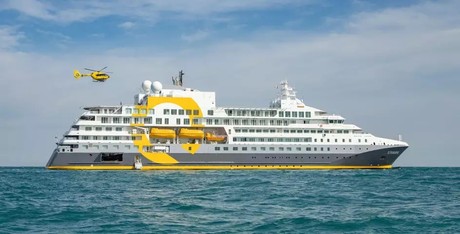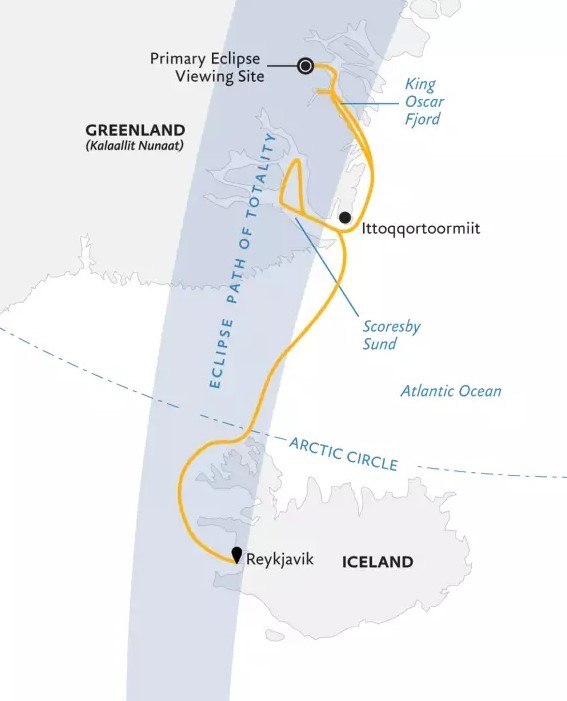
The genesis for our 13-day Iceland to Greenland: Total Solar Eclipse itinerary dates back to November 24, 2003, the day Quark Expeditions became the first and only operator to successfully lead a total solar eclipse voyage in remote Antarctica. On that day, we provided 100 people, from 17 different nations, the experience of becoming the first-ever humans to witness a total solar eclipse in Antarctica. Now we’ve decided to achieve a comparable feat in the Arctic. However, with innovation as our DNA, we set out to make it distinct from any other eclipse viewing experience in the industry.
We’ve assembled a taskforce of eclipse experts, a meteorologist and members of our Expedition Team to research the geography, terrain, angles of the sun in the sky, and Arctic weather patterns to prepare for one of the most rare experiences on the planet—observing a total solar eclipse in the High Arctic.
In addition to phenomenal eclipse viewing in the High Arctic, you’ll discover the natural wonders of the Vestfjords—the unsung secret of West Iceland. Our journey will also take us into the immense Northeast Greenland National Park, where we will cruise the 110-kilometer King Oscar Fjord. You’ll also get to unleash your inner adventurer on thrilling heli-flightseeing adventures over remote Greenland on Ultramarine’s state-of-the-art helicopters.
- Witness a total solar eclipse from a polar ship in the High Arctic
- Gain insight into the cultural and scientific significance of solar eclipses with guest experts David Baron Michael Zeiler
- Heli–flightsee over remote Greenland
- Cross the Arctic Circle twice— southbound and northbound
- Explore seldom-visited Westfjords, the hidden gem of west Iceland
- Sail across the Denmark Strait
- Witness the wildlife of Northeast Greenland National Park
- Cruise the 110–kilometer King Oscar Fjord.
Availability is always subject to confirmation. Please check with us before booking flights
Prices quoted here are often dependent on currency fluctuations. Please check with (01432 507450 or info@small-cruise-ships.com) for the very latest price, which may well be cheaper than the one advertised here.









After breakfast, you will be transferred to your ship, the technologically advanced Ultramarine. Today we set sail for what’s often referred to as “Iceland’s best-kept secret”—the Westfjords. This rugged peninsula, on the remote northwestern tip of Iceland, is a stunning region of mountains and fjords, hence its anglicized name, Westfjords. Mountains slope down to the sea in a dramatic fashion, providing plenty of opportunities for incredible landscape photography. We’ll spend the day exploring the fjords and shores of one of Iceland’s oldest regions (home to volcanic rocks dating back 16 million years) by Zodiac and ship, and during guided shore landings.
The views are diverse: dramatic cliffs, gushing waterfalls, colorful beaches, rolling green hills, high moorlands dotted with rocky outcrops and tiny lakes. You’ll likely spot Icelandic ponies and shaggy sheep grazing the hillsides. A few outposts of civilization include small fishing communities nestled on the edges of the fjord and along the shores of the Denmark Strait. These modest settlements preserve a maritime heritage that dates back to the heady days of the Viking era. Possible community visits include Vigur Island in Safjarðardjúp fjord, and the little town of Ísafjörður, noted for its wooden houses, fishing boats, and hospital-turned-community center.
As we sail north across the Denmark Strait between Iceland and Greenland, your Expedition Team will prepare you for the exciting adventures ahead—both on and off-ship. Our team of polar experts will present on a wide range of topics, including Arctic history, wildlife, geology, and climatology. The team will also search for seabirds soaring about the ship—and they’ll most certainly alert you whenever there’s a whale sighting.
Navigating within the boundaries of the Northeast Greenland National Park—the planet’s largest national park at 972,000 square kilometers—we will sail into Kangerluk Kong Oscar, also known as King Oscar Fjord, on the northern border of Scoresby Land peninsula. This major f jord system, poplar for its famously bright sandstone, stretches 110 kilometers long and 10 to 25 kilometers wide. When conditions allow, guests will have the opportunity to hike in Skipperdal Valley, where mineral deposits have painted the hills red and magenta—so landscape photographers take note.
As we prepare to position the ship in order to maximize views of the solar eclipse on Day 7, we’ll also have the opportunity to visit Blomsterbugten (also known as Flower Bay) on Ymer Island. The floral name was chosen by noted archeologists Gunnar Seidenfaden and Arne Noe-Nygaard during the Lauge Koch expedition in 1929 upon discovering an abundance of specimens for their botanical collection. Blomsterbugten is also home to a little hut known as “Varghytten” (the wolf hut). Built in 1929, the small hut is still used by the Sirius Patrol, a specialized military unit of the Danish Armed Forces. It’s possible we’ll also hike to the seldom-visited Noa Lake. There will be a palpable sense of excitement in the air as anticipation builds for our much-awaited eclipse viewing. Behind the scenes, your Expedition Leader, guest eclipse cartographer Michael Zeiler and the Ship Captain will work closely together— monitoring sea and ice conditions and atmospheric forecasts—to strategically position Ultramarine in the best location possible to maximize your views of the solar eclipse. Relatively few humans get to experience the awe of a polar expedition—but even fewer get to combine the wonders of an Arctic expedition with a solar eclipse viewing.
Expect presentations by our two special guests, eclipse experts David Baron and Michael Zeiler, in the leadup to the August 12 Solar Eclipse. (See profiles, page 20). These veteran eclipse enthusiasts will draw on their vast knowledge to ensure you have an eclipse viewing like no other.
On the evening of Day 6, guest expert David Baron will deliver a keynote presentation titled “Scientific America: The Eclipse That Enlightened A Nation,” during which he’ll delve into the societal impacts of eclipses. Baron will discuss how epic events such as a solar eclipse have spurred societies—and specific individuals—to achieve scientific greatness.
Ultramarine will sail further into King Oscar Fjord where the team will identify the most optimal viewing point along the path of totality. With the total eclipse of the sun lasting 2 minutes and 17.2 seconds, this region of the Arctic provides the longest duration of totality along the entire eclipse path. The eclipse will begin at 2:34 pm; totality will begin at 3:34 pm and end at 3:36 pm. The eclipse viewing experience, a duration of 2 hours, 1 minute, and 3 seconds, will conclude at 4:35 pm.
This 2026 eclipse is part of Saros series 126, which is a cycle of solar eclipses that repeats approximately every 18 years. It’s worth noting that total solar eclipses in Polar Regions are relatively rare due to the smaller land area and the fact that the sun only illuminates each pole for part of the year. To reiterate, the last total solar eclipse observable north of the Arctic Circle was 2008.
The Quark Expeditions team and guest eclipse experts have been and will continue to research the geography of this region as we prepare for the event. Right up until the day of the eclipse itself, our team will study the mountainous terrain, the angles of the sun in the sky, and weather patterns to determine the best possible viewing experience. Your Expedition Leader will outline the day’s agenda in the days and hours leading up to the total eclipse.
As we begin to make our way home— still overwhelmed no doubt by the previous day’s eclipse experience—we’ll visit Scoresby Sound (Scoresby Sund), a large fjord system on the eastern coast of Greenland. Except for a small population of Inuit at Ittoqqortoormiit, near the mouth of the fjord, Scoresby Sund is largely uninhabited. Warm water polynyas (areas of open water surrounded by sea ice) near the mouth of the fjord support diverse ecosystems of f lora and fauna, which is unusual for the Arctic. Numerous mountains, valleys and glaciers line the fjords, giving rise to a spectacular collection of icebergs. We also plan to journey through Bjornar (Nannut Qeqertaat), a group of islands (also known as Bear Islands) located northeast of Milne Land, named during the 1891-92 Den Østgrønlandske (East Greenland) expedition. The collection of 11 main islands fascinates visitors with its maze of channels, steep cliff faces and fascinating geology.
While exploring this area, you’ll enjoy Zodiac cruises and shore visits to several locations. We’ll also watch for grazing muskoxen as 40 percent of the world’s population lives in Northeast Greenland National Park. Sailing through spectacular Scoresby Sund, where many icebergs are birthed, you’ll immediately appreciate why previous visitors have described it as the most beautiful fjord system on the planet. We’ll visit sites such as Vikingbukta, known for its shoreline of basalt columns, and Sydkap, where you can explore the colorful tundra and remains of ancient Thule settlements.
Our Arctic adventure winds down as we sail back across Denmark Strait, southbound this time. We invite you to use your remaining time onboard to attend an educational presentation by one of our experts, share your photos, book a massage in Ultramarine’s Tundra Spa, sip an icy cocktail in the bar—or ask any questions you may have for our enthusiastic Expedition Team, who will also alert guests of any wildlife sightings.
Ultramarine

| Length: | 128m |
|---|---|
| Passenger capacity | 199 |
| Launched | 2020 |
Ultramarine is designed to go beyond the familiar in polar exploration, to discover new places, and to immerse you in the best the region has to offer.
Equipped with two twin-engine helicopters, Ultramarine offers the most robust portfolio of adventure activities in the industry, the most spacious suites in its category, breathtaking public spaces, and more outdoor wildlife viewing spaces than other expedition ships its size. It also features an innovative mix of sustainability features that exceed all industry standards.
With all this and more, Ultramarine is set to deliver the ultimate polar expedition experience.
Cabin - Spacious Entryways, Personal Safes, Spa-inspired Bathrooms, Heated Bathroom Floors, Premium beds and bed linens, Convertible Beds, Individual Temperature Controls, HD Flatscreen Televisions, Oversized Windows With Sweeping Views, Electrical Supply: 220V
Aboard - 2 Dining Areas, 4 Bars, Panorama Lounge, Lecture Theater, Library, Polar Boutique, Spa & Fitness Center, Oceanview Sauna, Zodiac Hangar with 4 Embarkation Points, 2 Ready Rooms with Individual Lockers, Walkaround Deck, Bridge
Activities - Flightseeing (Included), Zodiac Cruising (Included), Hiking (Included), Lectures (Included), Camping (Optional), Sea Kayaking (Optional), Stand-Up Paddleboarding (Optional), Paddle Excursions (Optional), Cross Country Skiing (Optional), Mountaineering (Optional)
Deck plans are for illustrative purposes only – The actual ship and cabin layout may differ.



